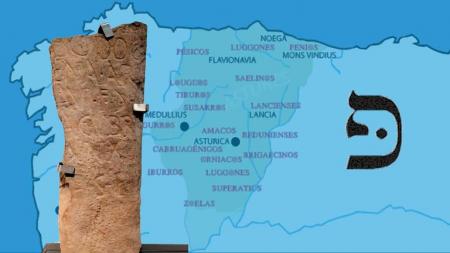News
|
Bodocena and the mysterious symbol: an enigma of Asturias in the Archaeological Museum

Bodocena and the mysterious symbol: an enigma in the Archaeological Museum of Asturias La Voz de Asturias 03 Nov 2022 The Archaeological Museum of Asturias has added to its collection the stele of Bodocena, a funerary tablet from the 1st century found in Belmonte de Miranda, a piece of remarkable historical interest due to the use of an indigenous anthroponym. It was found thirty years ago in an orchard in the town of Villaverde, after having been placed as a lintel in a butter shop. The tombstone bears an inscription that translates as 'Bodocena, daughter of Aravo, from the castellum Agubrigense, aged 12, is buried here'. The piece is of notable historical interest due to the use of an indigenous anthroponym, unheard of in the region, and the reference to the patronymic or filiation, although the most notable feature in the text is the inclusion of a symbol, interpreted by most specialists as an allusion to the place of origin or belonging of the individual. Margarita Fernández, professor of Medieval History at the University of Oviedo, explained on Thursday that the piece found 30 years ago, which always remained in the hands of the owner's family, was recognised by the locals who "knew it had letters on it" but did not know "what it was". During her visit to the municipality of Belmonte as part of the fieldwork for her thesis, she found "a lot of gold mining" in all the castreño settlements that had not been catalogued, and she contacted Ceferino Marrón, a cowherd from Villaverde, who told her that he had "a stone with letters on it". The researcher, who returned to the site in the following days, found that, as the stone was placed close to a wall, it could be "read perfectly", although the analysis took "a little more time", in which task she recalled the help she received at that time from Diego Santos, who recommended that she go to Ridea so that "they could publish the stele quickly". He revealed that the stone initially served as a lintel in a butter shop, and when "the stable was demolished" its owner "kept the stone because it was good enough to be used again for something else". According to Fernández, the stone slab was placed in the orchard of the owner's house, who "for a time charged a fee to be able to see it". In 1993, the professor found the stele, which she reported to the Museum, which at that time "did not have the funds to acquire it", so the discoverer negotiated with Marrón and then reported it to the Regional Ministry of Culture. The publication of the find by Ridea and the appearance in the media "truncated" the purchase process, as "collectors appeared who offered money" to the owner and "there was no way for it to go directly to the Archaeological Museum because there was already an economic transaction involved. In Asturias there are two other known examples in which this sign is recorded, although neither of them has, like the one from Villaverde, an archaeological context for the material find. The context of origin of the piece places it in the period of exploitation of the gold mines of the Begega mountain range during the Iron Age and the 1st century AD, it was reported. EFE |


